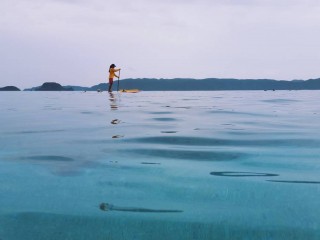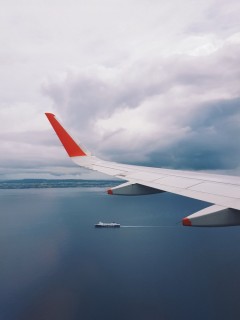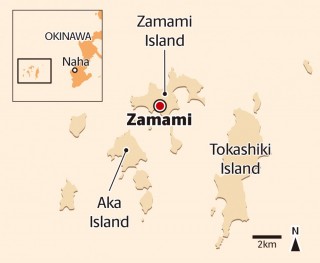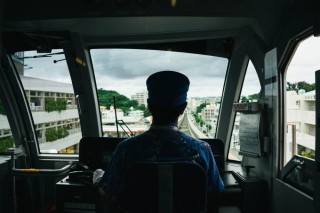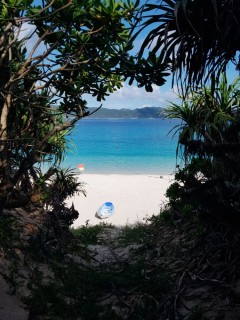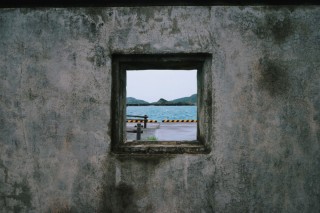Loading
Search
▼ Slowing Down Time With a Trip to Okinawa’s Zamami Island
- Category:Experience
Growing up in a small beach town on the west coast of Florida, much of my free time as a youth was spent in or around the Gulf of Mexico. The Gulf was almost always warm, not unlike bath water, yet it provided the perfect respite from the stifling heat of the Florida summers.
As a child I took all of this for granted, so it follows that now, as an adult, I long to recreate those carefree beach days. When a friend from San Francisco came to visit me in Tokyo, it was the perfect chance to recreate those youthful, aimless days of summers past — so off to Okinawa we went.
Okinawa is the largest in a series of islands, known as Ryukyu, situated about 1,500 kilometers southwest of Tokyo. The climate is humid and subtropical, with temperatures above 20 C throughout most of the year and a rainy season roughly from May until mid-June. The trick, where travel is concerned, is to get there in the magical week after the rainy season has ended but before the tourists arrive. Unfortunately, we missed the window. The photographer in me loves a tropical storm on a warm and moody beach, so regardless I was happy.
We spent our first few days around Naha (population 315,915), choosing to navigate the city on foot or using public transportation. Naha is a sprawling city with a total area of almost 40 square kilometers, but with a combination of walking, public transit and sweating profusely, getting around without a car is certainly doable.
It is no secret that the soul of most cities is in the details, and Naha is no different. Taking this into consideration, we often ventured out of our hotel for the day with no particular destination in mind.
It is no secret that the soul of most cities is in the details, and Naha is no different. Taking this into consideration, we often ventured out of our hotel for the day with no particular destination in mind.
Letting go of schedules and skipping the main tourism circuit allowed us to adapt to the slow pace of life and to relish the small details of life on the island, which made our experiences there even more meaningful. We watched beautifully adorned black and yellow spotted butterflies flutter about in Matsuyama Park, stumbled upon a small, protected shore called Naminoue Beach, and caught the sunset over a few Orion beers down at Naminouemisora Park.
No matter how insignificant our plans, we always found ourselves thoroughly engaged with our surroundings and happily conversing with the local people. On one such outing we met a group of retirees outside a convenience store who were curious as to what we were doing in the non-tourist area of the city. We ended up chatting for a good 15 minutes, (first in broken English and later in Japanese) about what brought us to the islands. These may seem like trivial moments, but they reinforced my belief that too many opportunities are missed when seated comfortably behind the glass of an air-conditioned automobile or tour bus.
It’s true that time seems to pass differently on Okinawa. The pace of life, even in the capital city of Naha, has a different viscosity than in the rest of Japan. Time seems to drip slowly, more like honey than water.
Even at times when punctuality is paramount — the monorail for example, which is always on time — the drivers pull in wearing Okinawan Kariyushi shirts. It’s a far cry from the neatly pressed, and often overly sterile, uniforms of the Tokyo Metro conductors. These bright blue shirts stamped with island flowers find their closest relative in the floral-patterned Aloha shirts of Hawaii and further enhance the tropical vibe of the city. The word “kariyushi” itself means happiness in the Okinawan dialect, and it is these little details that dissolve the misperception that a life worth living must always be dictated by the seconds hand of a watch.
It’s true that time seems to pass differently on Okinawa. The pace of life, even in the capital city of Naha, has a different viscosity than in the rest of Japan. Time seems to drip slowly, more like honey than water.
Even at times when punctuality is paramount — the monorail for example, which is always on time — the drivers pull in wearing Okinawan Kariyushi shirts. It’s a far cry from the neatly pressed, and often overly sterile, uniforms of the Tokyo Metro conductors. These bright blue shirts stamped with island flowers find their closest relative in the floral-patterned Aloha shirts of Hawaii and further enhance the tropical vibe of the city. The word “kariyushi” itself means happiness in the Okinawan dialect, and it is these little details that dissolve the misperception that a life worth living must always be dictated by the seconds hand of a watch.
Although we enjoyed our time in Naha, the decompression from Tokyo’s frantic pace was far from complete, so we boarded the Queen Zamami ferry headed to Zamami Island, part of a group of roughly 22 islands collectively known as the Kerama Islands. Zamami is about 40 kilometers or an hour’s ferry ride from Tomari Port in Naha, but it’s worlds away in terms of population (about 600 people) and pace of life — and it’s as beautiful as any of the Okinawan islands. In 2014, the Kerama Islands were designated as a National Park and the Kerama-Shoto Reef, just off the coast of Zamami, has had the distinction since 2005 of being a “Wetland of International Importance” under the Ramsar Convention.
The ferry to Zamami cruises the choppy seas at a good clip, so most people stay seated for the duration of the bumpy ride, but for those willing and able, the view from the afterdeck provides an impressive preview of the beauty that is in store. Dotting the deep-blue corridor of the sea are clusters of smaller, uniquely-shaped islands.
The ferry to Zamami cruises the choppy seas at a good clip, so most people stay seated for the duration of the bumpy ride, but for those willing and able, the view from the afterdeck provides an impressive preview of the beauty that is in store. Dotting the deep-blue corridor of the sea are clusters of smaller, uniquely-shaped islands.
These take on the appearance of so many lushly vegetated molehills strewn about the sea at random, and all are ringed by white sand beaches hauntingly devoid of inhabitants. As we stood on the deck and watched these islands loom into view, one after another, I finally started to feel far enough from the city.
Windswept and salt-stained, we pulled into the port of Zamami. Having just spent the past hour flirting with the sea on the ferry ride over, the urge to swim was strong, so we quickly disembarked and asked a few of the sun-tanned locals to point us in the direction of the nearest beach.
Furuzamami Beach was the consensus, so we hastily started the purported 20-minute walk through the village to get there. What we thought would be a brisk and purposeful walk straight to the ocean turned into two solid hours ambling about — and we were okay with that.
En route to our final destination, we first paused at a vibrant hibiscus bush flowering near the local community center, where we shot some photos and watched bumblebees alight. By then, the midday sun was reaching its zenith and temperatures were starting to peak, so we headed to the island’s only shop, Store 105, for some refreshments and a bite to eat. We sat on a bench and drank iced coffee from a can, eating homemade tuna onigiri rice balls in the shade, admiring the craftsmanship of the terra cotta ceramic tile roofs and limestone walls of the traditional Okinawan homes nearby.
Windswept and salt-stained, we pulled into the port of Zamami. Having just spent the past hour flirting with the sea on the ferry ride over, the urge to swim was strong, so we quickly disembarked and asked a few of the sun-tanned locals to point us in the direction of the nearest beach.
Furuzamami Beach was the consensus, so we hastily started the purported 20-minute walk through the village to get there. What we thought would be a brisk and purposeful walk straight to the ocean turned into two solid hours ambling about — and we were okay with that.
En route to our final destination, we first paused at a vibrant hibiscus bush flowering near the local community center, where we shot some photos and watched bumblebees alight. By then, the midday sun was reaching its zenith and temperatures were starting to peak, so we headed to the island’s only shop, Store 105, for some refreshments and a bite to eat. We sat on a bench and drank iced coffee from a can, eating homemade tuna onigiri rice balls in the shade, admiring the craftsmanship of the terra cotta ceramic tile roofs and limestone walls of the traditional Okinawan homes nearby.
The lunchtime interlude was nice but it was starting to getting late and we were losing precious daylight, so we finished our food and set out again in search of a the beach. We made our way past the port, through the sleepy village and onto the main road that led to the beach.
The last obstacle was a not-so-insignificant hill that took us a good 10 minutes to ascend. As we crested it, sounds of singing birds filled the air and sights of dense tropical foliage occupied our field of view. We excitedly descended into a verdant, if not overgrown, park that eventually led us to the shore.
As we approached the beach through a narrow, tree-lined path, the first thing that stood out were the cerulean blue waters and the rolling waves gently lapping at the ivory sand. Furuzamami beach was more beautiful than we could have imaged. It was at that moment that I realized I had finally found my way home.
The last obstacle was a not-so-insignificant hill that took us a good 10 minutes to ascend. As we crested it, sounds of singing birds filled the air and sights of dense tropical foliage occupied our field of view. We excitedly descended into a verdant, if not overgrown, park that eventually led us to the shore.
As we approached the beach through a narrow, tree-lined path, the first thing that stood out were the cerulean blue waters and the rolling waves gently lapping at the ivory sand. Furuzamami beach was more beautiful than we could have imaged. It was at that moment that I realized I had finally found my way home.
- May 23, 2017
- Comment (0)
- Trackback(0)


